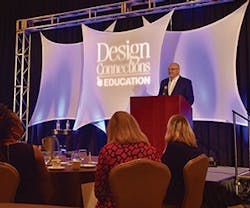Schools of the Future
In an effort to gather the experts in specified segments of the industry, interiors+sources’ Design Connections events bring together architects, designers, specifiers, and the manufacturers and suppliers that provide the best offerings for specialized projects. This December, i+s hosted its
second edition of Design Connections Education, which saw a host of prominent players in the field network, collaborate, take in educational sessions, and have some fun.
Raija Clar of HMC Architects in Sacramento, Calif., has been to two Design Connections events; she finds the gathering to be helpful in connecting with her peers. “It is good to find out that we all have the same issues and we all have the same passion about finding the right solutions for school design,” she said.
The event started with a session by Tracy Washington Enger, program manager of the U.S. EPA Indoor Environments Division, which provided insight that was new to some. She focused on the importance of indoor air quality in schools and how it affects students, teachers, and other staff. “Where kids learn is just as important as what they learn,” she noted. Her goal through her EPA programming is “to blend the physical environment and facilities with health and academics….”
Other information sessions included “Proven Strategies for Education,” in which Kevin Greischar, AIA, K-12 Education Leader, principal, DLR Group, reviewed a model that reinvents traditional “learning places” with a program that follows students from K-16 at the Missouri Innovation Campus; a presentation from IBI Group’s Sylvia Hajo and Rutu Sathia on the innovative Dr. Kirk Lewis Career & Technical High School in Pasadena, Texas, which provides focused technical training so students are career-ready upon graduation; and “Research Insights for Active Learning: K to Corporate Learning Places” from Dr. Lennie Scott-Webber, owner and principal of INSYNC: Education Research + Design. Key takeaways from her presentation and the majority of those over the course of the conference gave insight on how education design is evolving, and how environments throughout the commercial sector are starting to meld: the workplace is reminiscent of a playground or a kindergarten classroom (think the slides at Google and relaxed perch seating in offices) while today’s K-12 facilities are looking more like digital hubs.
“Boardroom” presentations from manufacturers and organizations working across the commercial design industry gave small groups of attendees a personalized look at the latest products and trends in the education segment. Even more intimate were one-on-one sessions which were scheduled ahead of time so each architect/designer/specifier had the opportunity to ask his or her own questions about their particular projects. This is often found to be one of the most useful features of i+s Design Connections events.
“I’ve been to a lot of different functions that were similar to this, but one of the things that really stood out about this experience was the opportunity to share insights and learn from and suggest ways of working with suppliers, which is something we typically don’t get the opportunity to do,” noted John Noble, project architect, SHP Leading Design, who was also a presenter at the event.
The hands-on portion of Design Connections Education was hosted by Toni Goke Wyre of Polk Stanley Wilson Architects. She tasked event goers with creating a design for “the school of the future.” The crowd broke up into groups to conceptualize and then worked with art supplies to build models of their collective visions. Sustainable attributes, technological features, furniture, lighting, and more were integrated into the designs.
Visit dsignconnections.com for more information on i+s events.
